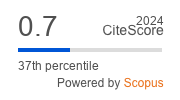Subclinical Hypothyroidism in Obese Iraqi Patients Attending Obesity Research and Therapy Unit
Keywords:
Subclinical hypothyroid, ORTU, Al-KindyAbstract
ABSTRACTBackground Subclinical hypothyroidism is mild thyroid hormone deficiency, defined by elevation of serum thyroid-stimulating hormone concentration despite a normal free T3, free T4 level, can be distinguished by clinical and circumstantial observations from other conditions that cause this constellation of laboratory findings. The aim is to find the prevalence, anthropologic, and metabolic changes associate subclinical hypothyroidism(SH) in adult patients presented to obesity research and therapy unit (ORTU Objective: To find the prevalence of subclinical hypothyroidism (SH) in adult obese patients presented to obesity research and therapy unit (ORTU) in AL-Kindy College of medicine and to describe the anthropologic and metabolic presentation of subclinical hypothyroidism in adults obese patients presented to ORTU. Method: A retrospective descriptive study of adult obese males and females patients attending ORTU during the period February 2013 to February 2014 aging 20-60 years. Patients grouped according to age and BMI. In addition to TSH, glucose, cholesterol, triglycerides and HDL are measured, results tabulated and analyzed. Results: This study revealed that (6.9%) had SH , 91 (86.7%) were females and 14 (13.3%) were males. TSH in patients with SH significantly rise with age (8.31 to 11.16 mu/l), in addition fasting glucose (104 to 116 mg/dl), total cholesterol and triglycerides also rise significantly. Increasing BMI associated with significant elevation of the mean level of TSH in patients with subclinical hypothyroidism (7.32 to 11.32 mu/l in BMI above 40). The same findings of the effect of increasing BMI on the mean level of fasting glucose (104 to 115), cholesterol and triglycerides. Conclusion: Prevalence of subclinical hypothyroidism in ORTU is about 6.9% with a significant association of increasing TSH with age and BMI. There were elevated fasting glucose, cholesterol, and triglycerides in SH patients that also increased significantly more with age and BMI.













